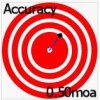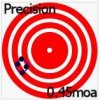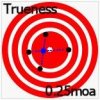Mikecr
Well-Known Member
As a walking varmint hunter I couldn't care less about grouping from my guns.
I need cold bore accuracy. Every shot. No matter the hot grouping capability.
-Forget MOA, it always comes down to IPHY(even if 1.047198" per 100yds), like it or not.
-Forget stretches to connect competitive shooting with hunting shooting. There is no useful correlation between preconditioned precision, and field accuracy.
1-IPHY don't get it for groundhogs across multiple fields. For their killzone of 3-4", my accuracy has to be twice that for most shots. That's [+or-] 2" per body shot. So 1-IPHY of accuracy would be limited to 200yds, head shots at [+or-]1.5", 150yds.
Them little 20cal plinkers cover this kind of stuff, and if your 338xx shoots no better than 1-IPHY, then you'll do no better with it for GHs.
I was offered $100 one day to eliminate a GH from a cemetery. 'Gray Ghost'. It turned out this was a serious challenge.
Nobody could get a clean shot, traps & gassing & filling holes didn't work, the cemetery was on a steep incline next to and facing a busy highway. I glassed it that evening & saw that this marmot understood effective use of cover, as if it knew it was safe only near those headstones. This is in a valley with a mountain across from it. I waited for a rainy day and then camped half way up that mountain on a big rock providing a clearing to the cemetery. About noon, still raining, he came out moon walking like a pop star. The rain was his cover that day.
624yds, 15deg down bubble, he sat up between stones and I put a Berger 95VLD through his chest.
This is a Browning A-Bolt action I had rubber bedded into an Eclipse stock, and had rebarreled to 6br. Not a BR gun, I would not count on it's button rifled 26" pencil to 5-sht group consistently better than ¾-IPHY. A lot of folks around here wouldn't put up with it.
But it's cold bore accuracy is far better: 2" from mark at 610yds(effective) is 1/3-IPHY, no sighters, or barrel warm-ups, and Harris bipod off a wet rock.
I couldn't do it 5 times fast. But I need to do it once for sure.
I had a $4500 tube gun(T2000, tactical, 6XC)(and way more invested incl scope) that grouped competitively(well under ½ IPHY hot grouping at 600yds). It was the most comfortable, fun shooting gun I ever owned. But it was never accurate enough for hunting. Not even close. From one 1st shot to another day 1st shot, maybe 1-IPHY, maybe worse..
I do have 2 other guns that are both great in grouping and also cold bore accuracy. One is a BR gun, the other a hunting gun, both cut rifled barrels.
My point is; you can find that a gun providing nice groups sucks for field accuracy, or that a gun which won't group for **** is the most accurate gun you've ever shot. You don't want to miss either attribute.
For LR hunting you need to know what you're actually capable of in the field -with one shot.
Like Bryan mentioned, and you should at least understand, precision and accuracy are different.
I need cold bore accuracy. Every shot. No matter the hot grouping capability.
-Forget MOA, it always comes down to IPHY(even if 1.047198" per 100yds), like it or not.
-Forget stretches to connect competitive shooting with hunting shooting. There is no useful correlation between preconditioned precision, and field accuracy.
1-IPHY don't get it for groundhogs across multiple fields. For their killzone of 3-4", my accuracy has to be twice that for most shots. That's [+or-] 2" per body shot. So 1-IPHY of accuracy would be limited to 200yds, head shots at [+or-]1.5", 150yds.
Them little 20cal plinkers cover this kind of stuff, and if your 338xx shoots no better than 1-IPHY, then you'll do no better with it for GHs.
I was offered $100 one day to eliminate a GH from a cemetery. 'Gray Ghost'. It turned out this was a serious challenge.
Nobody could get a clean shot, traps & gassing & filling holes didn't work, the cemetery was on a steep incline next to and facing a busy highway. I glassed it that evening & saw that this marmot understood effective use of cover, as if it knew it was safe only near those headstones. This is in a valley with a mountain across from it. I waited for a rainy day and then camped half way up that mountain on a big rock providing a clearing to the cemetery. About noon, still raining, he came out moon walking like a pop star. The rain was his cover that day.
624yds, 15deg down bubble, he sat up between stones and I put a Berger 95VLD through his chest.
This is a Browning A-Bolt action I had rubber bedded into an Eclipse stock, and had rebarreled to 6br. Not a BR gun, I would not count on it's button rifled 26" pencil to 5-sht group consistently better than ¾-IPHY. A lot of folks around here wouldn't put up with it.
But it's cold bore accuracy is far better: 2" from mark at 610yds(effective) is 1/3-IPHY, no sighters, or barrel warm-ups, and Harris bipod off a wet rock.
I couldn't do it 5 times fast. But I need to do it once for sure.
I had a $4500 tube gun(T2000, tactical, 6XC)(and way more invested incl scope) that grouped competitively(well under ½ IPHY hot grouping at 600yds). It was the most comfortable, fun shooting gun I ever owned. But it was never accurate enough for hunting. Not even close. From one 1st shot to another day 1st shot, maybe 1-IPHY, maybe worse..
I do have 2 other guns that are both great in grouping and also cold bore accuracy. One is a BR gun, the other a hunting gun, both cut rifled barrels.
My point is; you can find that a gun providing nice groups sucks for field accuracy, or that a gun which won't group for **** is the most accurate gun you've ever shot. You don't want to miss either attribute.
For LR hunting you need to know what you're actually capable of in the field -with one shot.
Like Bryan mentioned, and you should at least understand, precision and accuracy are different.



